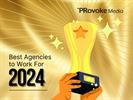Paul Holmes 06 Nov 1992 // 12:00AM GMT
The '80s were a boom time for corporate identity specialists. The wave of mergers and acquisitions that washed over corporate America during that decade resulted in a flood of assignments for those who dealt in renaming and visually interpreting organizations. New names and new logos were spawned at a phenomenal pace, many of them apparently meaningless and with little real-world connection to the corporations they were intended to identify.
That boom may be over but the best corporate identity consultants are only now coming into their own, challenging for a place at the top table of corporate communications.
Many public relations people, more familiar with words than pictures, have traditionally dismissed corporate identity as a superficial, cosmetic business, more concerned with image than with reputation. To a large extent, their dismissal has been justified. But corporate identity is evolving.
"Our society has a tendency to turn to superficial imagery to solve deep-seated problems," says Alan Siegel, chairman and ceo of New York-based corporate identity firm Siegel & Gale. "In the world of business, companies that are not clear about their own missions or face unaccustomed competition, think the answer is to create a bold new name, design a jazzy trademark, or come up with a catchy advertising slogan."
That thought is echoed by Gene Grossman, a principal of the international design firm Anspach Grossman & Portugal, who says corporate identity firms have tended to approach corporate communications from an exclusively design perspective, with unfortunate results.
"A lot of design programs for corporations are designed to be beautiful and aesthetically pleasing," Grossman says. "They're done by the intuition of the designer, what he thinks it should be. He may go and talk to some of the management, even a few people in the field; he may gather information, but it is generally so superficial that he hasn't even penetrated the first layer."
Today, it is possible to hold a lengthy conversation with leading corporate identity experts and never hear the word "logo" or "design". While the end product of most corporate identity programs may be a new name or trademark, consultants believe the process—which involves a startling degree of self-analysis—is more important than the product.
"Corporate identity involves more than changing and communicating a name," says Anspach's Joel Portugal. "It is the comprehensive presentation of what a corporation is, where it is going, how it is different.
More than describing what a corporation is, corporate identity seeks to project what makes a company special in order to influence the perceptions and actions of a diverse set of audiences."
Siegel & Gale's Alan Siegel has taken this position one step further. He prefers not to use the words "corporate identity" and talks instead about "corporate voice."
"Corporate voice begins with all the company's inherent values and encompasses the ways it interacts with its various publics, unifying its diverse exposures to build a coherent, focused personality for the corporation," says Alan Siegel. "Unlike corporate identity, it is not limited to visual communications."
Corporate voice, Siegel says, begins with self-knowledge. A corporation has to define what it does, what it stands for, and what sets it apart from and distinguishes it from its competition.
All of which sounds like classic public relations thinking. The message in that ought to be clear: corporate identity consultants believe that the process through which corporations analyze the messages they are sending is an excellent starting point for understanding corporate personality, and thus for building corporate reputation.
Ed Vick, president and CEO of San Francisco-based Landor & Associates, says corporate identity consultants have a unique opportunity in this regard because unlike PR and advertising agencies they have no ongoing relationship with a company and tend to be called in only when there is a crisis, and therefore an opportunity.
"Change is the biggest catalyst for taking a look at identity," be says, "and because a company is going through change it is ready to listen to new ideas and new perspectives. We can bring those perspectives because we are outsiders, we don't have an ongoing relationship with a company, so we don't have preconceived ideas."
One example Siegel cites of a company with a strong and distinctive "corporate voice" is Herman Miller. The furniture maker, he contends, has a voice that springs from its unique approach to business and helps define the company as "egalitarian, erudite, innovative and idealistic."
"Rooted in the fabulous design tradition of its furniture, the company's strong visual sensibility carries over into publications, advertising, architecture, even posters," he says.
Apple is another example. Its voice, Siegel says, is "brash, exuberant and irreverent" and has helped the company position itself as one that sets out to empower the individual. Siegel quotes Apple chairman John Sculley, who has said that every piece of communication from Apple is a statement about what the company stands for.
The first step in identity change, the experts agree, is research that analyzes the company's current image and positioning, using both surveys of the organization's various audiences, examination of communications materials, and an analysis of the strategic business plan.
"It is important to establish a clear position for the corporation," says Joel Portugal. "This begins with identifying the image attributes that currently describe the corporation, along with a set of ideal image attributes that are desired for dominating perceptions of the corporation in the future."
At this stage, Portugal says, companies should compare the present corporate name with the company's current stable of businesses, and ask whether the name adequately conveys the range of products and services, whether it indicates a specific purpose or a vague, diffuse one, whether it is sufficiently distinctive.
Alan Siegel urges companies not to throw away established names unless it is absolutely necessary, and to examine the names a company already uses for subsidiaries and brands and strongly suggests giving priority to real words or combinations of real words over fabricated words or initials, pointing out that real words do not have to be explained.
One company for which a name change was necessary was Sara Lee Corporation, formerly Consolidated Foods. The company was turning in positive bottom-line results but appeared to be undervalued. The name itself was a problem, management decided, since it was misleading: the company was neither consolidated nor exclusively involved in foods.
"Sara Lee was one of the early and somewhat controversial candidates," recalls Portugal. "Prevailing wisdom warned of the risk of naming the entire company after just one brand, but an examination of 100 consumer product companies on the New York Stock Exchange showed that companies using brand names commanded higher market valuation."
The name was widely recognized, and communicated attributes such as quality and value, and less than a year after the name change, awareness of the company had jumped from 93% to 100% among securities analysts and from 76% to 100% among the media. CEO John Bryan said any doubts about the name change vanished when the company rose to the top of the list in the food industry in Fortune's Most Admired Corporations survey. "The company was no different," he said. "The difference was the name."
Others, however, have changed names and identities to little purpose. British corporate identity guru Wally Olins, author of Corporate Identity, cites Exxon as one example, formerly Standard Oil of New Jersey and also known as Esso in certain parts of the world.
Olins says: "It says nothing about the company or its relationships with people. It is particular ironic that the company has used a highly imaginative and flexible piece of symbolism for some years: the Esso tiger. Exxon ended up at a cost of millions of dollars with another design that says nothing to anybody except: `This is me, here I am. Aren't I big?"
Companies also need to consider whether they require a monolithic, endorsed or branded identity. A monolithic identity employs one name and visual style throughout (IBM, for example); an endorsed identity occurs when the corporation has a group of subsidiaries endorsed with the corporate name (General Motors); a branded identity allows its brands to stand more or less alone (Procter & Gamble.)
"While management is often driven to create a 'one-company' image, it is important to evaluate all communications and marketing equity at various levels of the hierarchy," Portugal says. "You have to ensure that no proprietary or franchise value is discarded and lost."
The final step is communicating the identity change to various audiences. "The need to support the new identity with proactive audience management strategies and programs is often overlooked," Portugal says.
Ed Vick agrees. He says the smart CEO can use a new corporate identity program to help communicate his objectives and the corporation's mission to both internal and external audiences, and cites General Electric.


































.jpg)

















